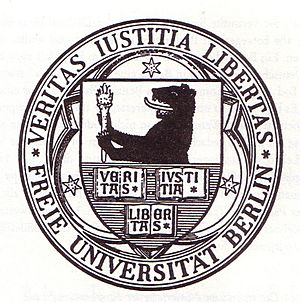Free University of Berlin facts for kids

Seal of the Freie Universität Berlin
|
|
| Latin: Universitas Libera Berolinensis | |
| Motto | Veritas, Iustitia, Libertas (Latin) |
|---|---|
|
Motto in English
|
Truth, Justice, Liberty |
| Type | Public |
| Established | 1948 |
| Budget | 414 Mio. € (2012, without the Charité) State: 302 Mio. € External: 112 Mio. € |
| President | Peter-André Alt since 2010 |
|
Academic staff
|
430 professors (incl. 94 junior professors) |
| Students | 34,518 (WS 2013/14) |
| Address |
Freie Universität Berlin
,
Kaiserswerther Straße 16-18 14195 Berlin Dahlem
,
,
|
| Campus | Suburban and Urban 1.8 km2 (180 ha) |
| Colors | Light Green / Dark Blue |
| Nickname | FU, sometimes "FUB" |
| Affiliations | UNICA, EUA, German Excellence Initiative, Deutsche Forschungsgemeinschaft (DFG), German U15, Charité - University Medicine Berlin |
The Freie Universität Berlin (which means "Free University of Berlin") is a famous university in Berlin, Germany. People often call it FU Berlin for short. It is known for its great research in many areas. These include subjects like humanities (like history and languages) and social sciences (like how societies work). It also excels in natural and life sciences (like biology and chemistry).
This university was started in 1948. This was during the Cold War, a time when Berlin was divided. It was founded in Berlin-Dahlem, a part of the city in the southwest. Today, the university has three main areas, called campuses. The main campus is in Dahlem. There is also the Campus Düppel for animal studies and veterinary medicine. The Geocampus in Lankwitz is where students learn about Earth sciences.
The medical part of Freie Universität Berlin is special. It is part of the Charité - University Medicine Berlin. This is a joint medical school with another big university, Humboldt University. The university library at Freie Universität is very large. It has about 8.5 million books and other items. This makes it the biggest university library system in Germany.
Freie Universität works with over 400 universities around the world. Many of these partnerships are through the ERASMUS programme. This program helps students study in different countries. Many international rankings show that Freie Universität is one of the best universities in Germany. In 2007 and again in 2012, it won a national competition called the German Excellence Initiative. This showed it was one of the top universities in the country. Many famous people have studied here. This includes five Nobel Prize winners.
Contents
What Can You Study at Freie Universität?
Freie Universität Berlin offers more than 150 different subjects. These subjects are taught in 12 main departments and three special institutes. Here are some of the main areas you can study:
- Department of Biology, Chemistry, and Pharmacy
- Department of Earth Sciences (about our planet)
- Department of History and Cultural Studies
- Department of Law (learning about rules and justice)
- School of Business and Economics (about money and how businesses work)
- Department of Mathematics and Computer Science
- Department of Education and Psychology (about learning and the mind)
- Department of Philosophy and Humanities
- Department of Physics (about how the world works)
- Department of Political and Social Science (about governments and society)
- Medical School: Charité - Universitätsmedizin Berlin (shared with Humboldt University Berlin)
- Department of Veterinary Medicine (for animal health)
Special Study Centers
Freie Universität also has special centers for certain topics. These are called interdisciplinary central institutes. They bring together different subjects to study a specific region.
- John F. Kennedy Institute for North American Studies
- Institute for Eastern European Studies
- Institute for Latin American Studies
Botanical Garden
The university is also home to a huge Botanical Garden. This garden has over 22,000 different kinds of plants. It is one of the biggest botanical gardens in the whole world. It's a great place to learn about plants from all over.
Images for kids
-
Kaiser Wilhelm Institute for Chemistry in 1911. Today, the Hahn-Meitner building houses the Institute for Biochemistry, where nuclear fission was discovered.
-
John F. Kennedy, 1963: This school [...] must be interested in turning out citizens of the world, men who comprehend the difficult, sensitive tasks that lie before us as free men and women, and men who are willing to commit their energies to the advancement of a free society.
-
The "Henry Ford" building
-
Interior of the Philological Library designed by Sir Norman Foster
-
Institute of Computer Science – Dept. of Mathematics and Computer Science
-
Institute of plant physiology and microbiology – Dept. of Biology, Chemistry, Pharmacy
See also
 In Spanish: Universidad Libre de Berlín para niños
In Spanish: Universidad Libre de Berlín para niños


















